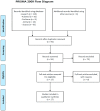Peer Victimization and Onset of Social Anxiety Disorder in Children and Adolescents
- PMID: 31174384
- PMCID: PMC6627045
- DOI: 10.3390/brainsci9060132
Peer Victimization and Onset of Social Anxiety Disorder in Children and Adolescents
Abstract
Background: In the literature, several studies have proposed that children and adolescents with social anxiety had experienced previously victimization from peers and siblings. The aim of this review was to contribute to the updating of recent findings about the relationship between peer victimization and onset of social anxiety in children and adolescents.
Methods: A selective review of literature published between 2011 and 2018 on Social Anxiety Disorder in children and adolescents that experienced peer victimization during childhood and adolescence.
Results: Seventeen studies are included. All studies showed that peer victimization is positively correlated to the presence of social anxiety. Moreover, the perpetration of peer victimization may contribute to the maintenance and the exacerbation of social anxiety symptoms.
Conclusions: In children and adolescents with Social Anxiety Disorder, it is necessary to evaluate firstly the presence of peer victimization experiences. Subsequently, therapeutics programs targeted to elaborate these experiences and to reduce the anticipatory anxiety and the avoidance that characterized these children and adolescents can be proposed.
Keywords: adolescents; bullying; children; peer victimization; social anxiety.
Conflict of interest statement
The authors have declared that no competing interests exist.
References
-
- Haynie D., Nansel T., Eitel P., Crump A., Saylor K., Yu K. Bullies, victims and bully/victims: Distinct groups of at-risk youth. J. Early Adolesc. 2001;21:29–49. doi: 10.1177/0272431601021001002. - DOI
-
- Olweus D. In: The Nature of School Bullying. A Cross-National Perspective. Smith P.K., Morita Y., Junger-Tas J., Olweus D., Catalano R., Slee P., editors. Routledge; London, UK: New York, NY, USA: 1999.
-
- Dooley J.J., Pyzalski J., Cross D. Cyberbullying versus faceto-face bullying: A theoretical and conceptual review. Z. Psychol. 2009;21:182–188. doi: 10.1027/0044-3409.217.4.182. - DOI
Publication types
LinkOut - more resources
Full Text Sources


